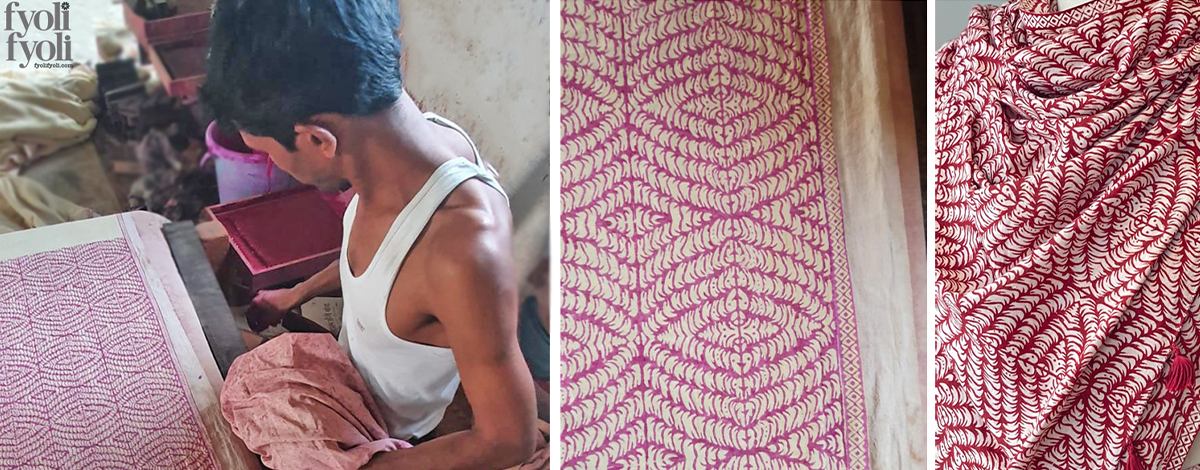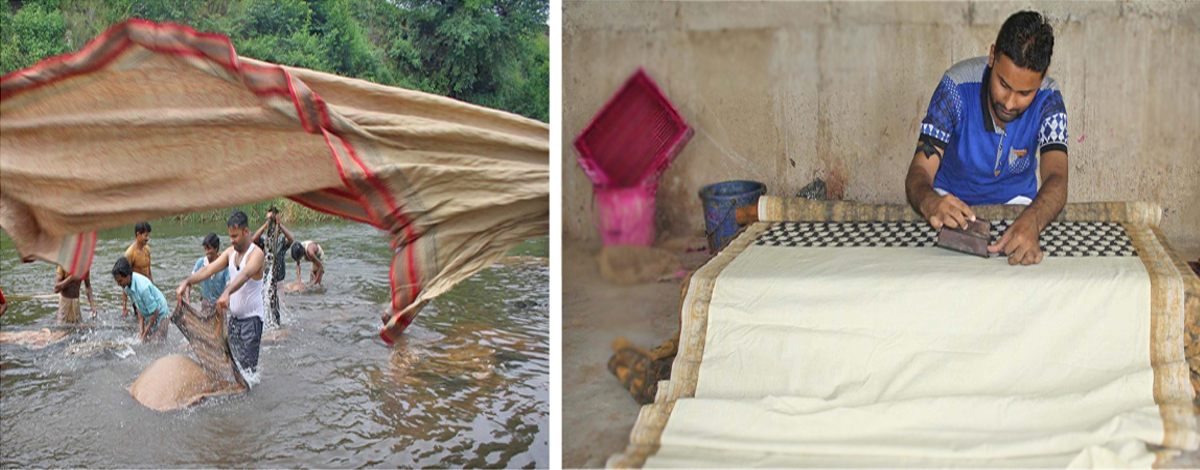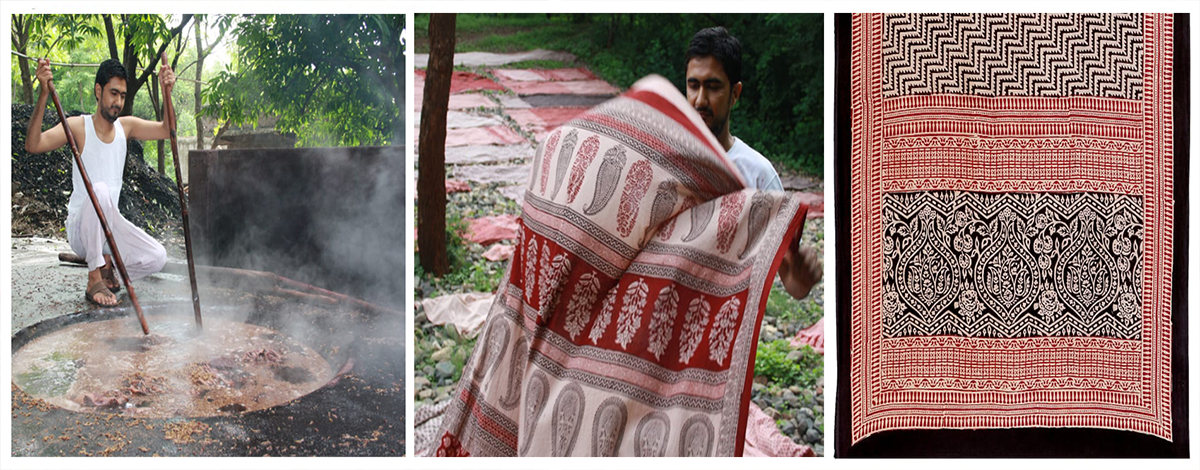Free shipping in India/Flat $16 Worldwide.


Bagh is a traditional block print technique practiced in Bagh region of Madhya Pradesh in India. Village Bagh is famously known for its Bagh caves which belonged to the Buddhist faith during 8th-10th century AD and was once an abode of Tigers. That’s where the region and Bagh print got its name from, as Tiger in Hindi translates to Bagh. Bagh is one among several other block printing techniques practiced in India like that of Ajrakh, Dabu, Sanganeri, Kalamkari, Bagru, Nandana etc. to name a few. What distinguishes Bagh from other prints are extensive use of red and black dyes obtained from natural pigments, it’s close proximity to mineral rich water of Baghini river which provide unique luster to fabrics and its patterns, which are inspired from ancient Bagh cave paintings amalgamated well with geometrical and natural botanical forms.


Figure 1 Photo Courtesy Mohmd. Arif Khatri
Bagh is one of the most eco-friendly ways of printing and dyeing textiles. Bagh print is created through several processes of washing, dyeing and printing textiles which demands extreme manual labor and time. We have reimagined Bagh prints by developing our own textile prints in this technique but the process remains same.
First, the textile preferably cotton or silk is washed and beaten on riverbeds of Baghini to remove impurities and starch, then sun dried and later dunked into a mixture of Castor oil, Salt and goat excreta.
Washed again and dried it is then treated into solution of Myrobalan which acts as mordant for dyes to be applied later. Now comes the printing part where the signature red color is obtained by boiling Alum in water, storing it in a pot and then boiling it again like a starch glue with powdered tamarind seed. At this point the color is Fuchsia pink. (first two slides on figure3) It turns into deeper red (last slide on figure3) when boiled in a mixture of mulberry root bark and Alizarin as described in the following passages.
Similarly the signature black is obtained by boiling ferrous-sulfate or rusted iron in water with jaggery, lime and wheat flour. Other colors are also used to a limited extent in Bagh like that of Blue which is obtained from Indigo and Khaki which is obtained from Axle wood leaves and Pomegranate skin.


Figure 2 Image Courtsey Mohmd. Bilal Khatri
These dyes are then printed upon textiles with the help of intricately hand carved wooden blocks and left to dry and then washed again in flowing river water to remove residual dye.
Finally the printed fabric is boiled and tossed in a heated copper vessel which contains a mixture of roots bark from Indian mulberry and Alizarin, first synthetically produced natural dye and is used as an alternative these days for madder plant dyes. This concoction helps in color fixing and fastening by acting as a resist dye which allows the signature deep red and black to emerge to its full potential.
Figure 3 @fyolifyoli
If we dive deep into history we will find that the practice of natural dyeing and block printing have been in existence in Indian subcontinent since ages, archaeological evidence of which can be traced back to Indus Valley Civilization in form of a madder dyed red piece of cloth unearthed from Mohenjo Daro which dates back to 2600-1900 BCE. Other evidence is minute dyed fragments of cotton recovered from Mehrgarh dating back somewhere around 2000 BCE. Another striking evidence is the presence of a textile fragment dyed with Indian madder found in the tomb of Pharaoh Tutankhamun. Alum, which is one of the most commonly used mordants, was unearthed during the same period from Egypt. This substantiates the claim that there was presence of trade relations between these two flourishing civilizations and people back then had an advanced understanding of the process of dying and colour fixing on textile by mordant. When it comes to block printing, earliest evidence of it can be traced back to 4000 years ago from China. Block printing earlier was used to print texts on papers, mostly sacred texts. The first evidence of block printing being used on textile dates back to 2nd Century AD from the Han Dynasty. Both these techniques of block printing and natural dying coincided at a certain point of time in history and block printing on textiles started flourishing in the Indian subcontinent by early 11th century. It was then patronized by Mughal emperors specially Shahjahan who was quite fond of this craft and under his reign block printing saw some of its golden days. During the same period, a clan of Khatris settled in Larkana region of Sindh province in Pakistan on the banks of Indus river. They used to make block printed textiles known as Ajrakh for the well to do Pastoralist community known as Maldharis. Khatris were asked to settle in Kutch by King of Kutch, Raja Bharmal 1 in 1589. Several such waves of migration from Sindh region happened Eastwards later on to Marwar, Pali in Rajasthan and subsequently to Manawar in Madhya Pradesh. These clans settled in different regions gave the craft of block printing it’s different forms and different names. One such clan in 1962 headed by Ismail Suleiman Khatri settled in Bagh region of Madhya Pradesh due to presence of mineral rich water of Baghini river. This is called as the soul of Bagh print as it brings a distinct luster to the prints. He evolved the craft of block printing to more complex yet refined form introducing new patterns and designs to the craft and that’s how the famous Bagh Print as known today came into existence.
Researched and written by Anjan Singh with contribution by Meenu Devrani
All Copyright © 2021 fyolifyoli
Designed, Developed, Marketed & Managed by Tenjump
All Copyright © 2021 fyolifyoli
Designed, Developed, Marketed & Managed by Tenjump
| Cookie | Duration | Description |
|---|---|---|
| cookielawinfo-checbox-analytics | 11 months | This cookie is set by GDPR Cookie Consent plugin. The cookie is used to store the user consent for the cookies in the category "Analytics". |
| cookielawinfo-checbox-functional | 11 months | The cookie is set by GDPR cookie consent to record the user consent for the cookies in the category "Functional". |
| cookielawinfo-checbox-others | 11 months | This cookie is set by GDPR Cookie Consent plugin. The cookie is used to store the user consent for the cookies in the category "Other. |
| cookielawinfo-checkbox-necessary | 11 months | This cookie is set by GDPR Cookie Consent plugin. The cookies is used to store the user consent for the cookies in the category "Necessary". |
| cookielawinfo-checkbox-performance | 11 months | This cookie is set by GDPR Cookie Consent plugin. The cookie is used to store the user consent for the cookies in the category "Performance". |
| viewed_cookie_policy | 11 months | The cookie is set by the GDPR Cookie Consent plugin and is used to store whether or not user has consented to the use of cookies. It does not store any personal data. |
Register


Login to your account